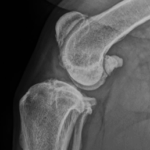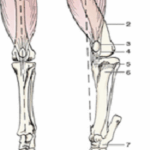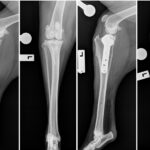
Xray of a hip affected by Hip Dysplasia
Hip dysplasia is a relatively common problem in medium to large sized dogs which can cause a lot of pain and arthritis in affected dogs.
What is Hip Dysplasia?
The hip joint is what we call a “ball and socket” joint. The ball at the top of the femur (the bone in the upper leg) should fit firmly and securely in the socket of the pelvis. Hip dysplasia occurs when the ball and socket don’t fit together properly. This leads to looseness in the joint which causes the wrong parts of the joint to rub together. This cases pain in the short term, and leads to arthritis in time.
What causes hip dysplasia?
Hip dysplasia is quite a complex condition. It has a very strong genetic component, but it is also influenced by other factors such as rate of growth, type of feeding, exercise levels, and other co-existing skeletal disorders such as spinal disease, trauma, bone or joint disorders of forelimbs.
What are the signs of hip dysplasia?
The most common signs of hip dysplasia include stiffness affecting the back legs, a “swaying” of the back end when the dog walks, and difficulty rising. In older dogs, we tend to see more pain due to the arthritis which develops.
How can hip dysplasia be treated?
Unfortunately, the hips of affected dogs will never be returned to “normal”. Treatment is generally about managing the disease rather than curing it.
For mild to moderate cases, we tend to use a combination of treatment options:
- Disease Modifying Osteoarthritis Drugs. These drugs are given as injections under the skin once each week for four weeks. We then repeat the course every six months. These drugs help reduce damage within the joint, as well as having some anti-inflammatory effect.
- Non-Steroidal Anti-Inflammatory Drugs. These are a group of drugs with good pain relief and anti-inflammatory effects. Think of it as Neurofen for dogs (please note: ibuprofen can be very toxic to dogs so please only use medications prescribed by a vet)
- Other pain killers: for severe cases, we may use other pain killers such as tramadol and gabapentin
- Weight management. This is critical for any dog with joint problems. The more weight a dog carries the more pressure on joints. Weight management in some cases can even give better results than medication.
- For severely affected animals, surgery may be needed. This may be a hip replacement, removing the hip joint, or cutting the nerves to the hip. Each surgery type as risks and benefits, so your vet will advise which options may be best for your pet
How do you prevent hip dysplasia?
As with so many conditions, prevention is better than cure. The first thing to remember is that hip dysplasia has a strong genetic component, so breeding from dogs with healthy hips is critical. For dog breeds which are prone to hip dysplasia (such as German Shepherds, Golden Retrievers and Labradors), it is vitally important to ensure the parents have been hip scored and have good hips. Before purchasing a dog, you need to check if the breed is prone to hip dysplasia, and if so ensure the parents have been tested and have good scores.
Keeping your growing pup at an ideal weight is also very important. Excessive weight puts more strain on developing joints, which can contribute to the damage.
Controlling the growth rate of puppies can affect the risk of developing problems. For large breed dogs, there are foods specifically designed to control their growth rate. They still end up the same size when fully grown, but they reach full height slower. We recommend feeding a good quality “large breed” dog food to growing dogs.
Exercise is another factor which can influence hip development. Moderate amounts of low-impact exercise are recommended for growing puppies. High impact exercise such as jumping and chasing balls can cause microfractures in developing bones and joints, leading to arthritis and contributing to hip dysplasia development.
For more information on raising a puppy, head to https://bunburyvets.com.au/wp-content/uploads/2017/03/2017_bc_ePDF_new_dog_guide.pdf and download a copy of our free New Dog Guide.



